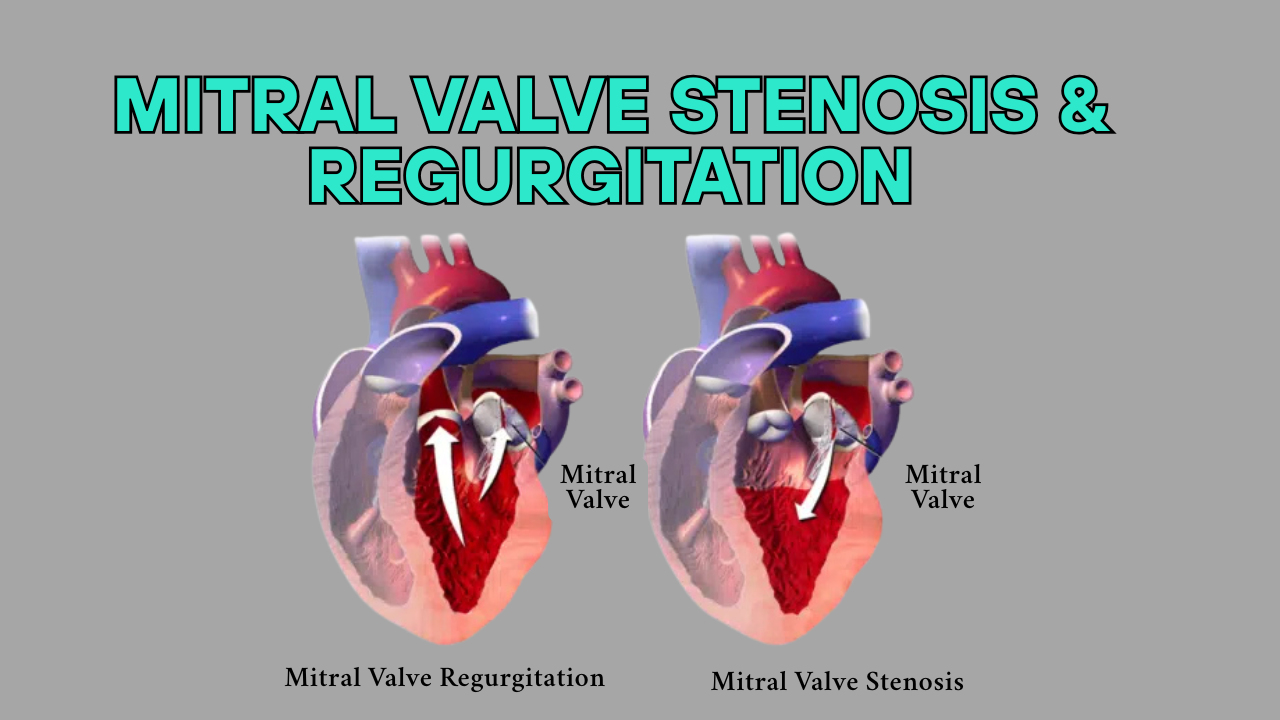- everything you need to know about -
Mitral Valve Stenosis & Regurgitation
watch a
video
- HEALTH & WELLNESS-
Mitral Valve Stenosis
& Regurgitation
Heart health is essential, but certain conditions can go unnoticed until they affect daily life. Two common issues involving the heart’s mitral valve are mitral valve stenosis and mitral valve regurgitation. These problems may sound complex, but they affect thousands of people around the world—sometimes without obvious warning signs.
In this blog post, we’ll explain these conditions in simple terms, cover their causes and symptoms, and share what treatment options are available.
What Is the Mitral Valve?
Your heart has four valves. One of them is the mitral valve, located between the left atrium and left ventricle. Its job is to ensure that blood flows in one direction — from the lungs to the heart and then out to the rest of the body.
When this valve doesn’t function properly, it can disrupt blood flow, placing extra strain on the heart and lungs. That’s where mitral valve stenosis and mitral valve regurgitation come in.
What Is Mitral Valve Stenosis?
Mitral valve stenosis happens when the valve becomes narrowed or stiff. This prevents blood from flowing freely from the upper chamber to the lower chamber of the heart.
🔍 Common causes include:
Rheumatic fever (a complication of untreated strep throat)
Calcium buildup on the valve
Congenital heart defects (from birth)
⚠️ Symptoms may include:
Shortness of breath (especially during activity)
Chest discomfort or pressure
Fatigue or feeling tired easily
Irregular heartbeat or heart murmur
Swelling in the ankles or feet
Because it progresses slowly, many people don’t realize they have it until symptoms become hard to ignore.
What Is Mitral Valve Regurgitation?
Mitral valve regurgitation, also known as a leaky heart valve, occurs when the valve doesn’t close tightly. This allows blood to flow backward into the upper chamber of the heart, reducing the efficiency of your heart’s pump.
🔍 Common causes include:
Mitral valve prolapse
Heart attack damaging the valve
Infection like endocarditis
Aging and wear over time
⚠️ Symptoms may include:
Shortness of breath, especially when lying down
Feeling tired or weak
Cough, especially at night
Fast or irregular heartbeat
Dizziness or lightheadedness
In mild cases, a person might not notice any symptoms for years. In more severe cases, it can lead to heart failure if left untreated.
How Are These Conditions Diagnosed?
If you experience symptoms like shortness of breath, chest pain, or unusual fatigue, your doctor may listen for a heart murmur, a common sign of valve problems.
Diagnostic tools may include:
Echocardiogram (an ultrasound of the heart)
Electrocardiogram (ECG or EKG)
Chest X-ray
Cardiac MRI or CT scan
Stress testing or heart catheterization
Early diagnosis is key to managing symptoms and preventing complications.
Treatment Options
Treatment depends on how severe the condition is and how it affects your daily life. Common treatments for mitral valve stenosis and regurgitation include:
💊 Medications:
To control blood pressure, heart rate, or fluid buildup
Diuretics to reduce swelling
Anticoagulants (blood thinners) to prevent clots
🛠️ Procedures or Surgery:
Balloon valvuloplasty (used in stenosis to widen the valve)
Mitral valve repair (preferred when the valve can be fixed)
Mitral valve replacement (if repair isn’t possible)
Minimally invasive techniques and robotic-assisted surgeries are now more common, offering faster recovery and fewer complications.
Living With a Mitral Valve Condition
Many people live long, active lives with heart valve disease, especially when the condition is diagnosed early and treated properly.
Here are some ways to support heart health:
Keep blood pressure under control
Eat a heart-healthy diet (low in salt and processed food)
Avoid smoking and limit alcohol
Stay physically active as advised by your doctor
Keep regular check-ups with a cardiologist
If you’ve been told you have a mild heart murmur or leaky valve, don’t panic. Many cases are monitored over time and don’t require surgery unless symptoms progress.
Final Thoughts
Mitral valve stenosis and regurgitation are more common than most people think. While the names may sound intimidating, understanding the basics can help you stay alert to symptoms and take early action.
Whether it’s unexplained fatigue, shortness of breath, or a detected heart murmur, listening to your body—and your heart—is the first step toward better health.
If you or a loved one has been diagnosed with a mitral valve condition, know that you’re not alone. With medical advances and personalized treatment plans, living a full life with heart valve disease is absolutely possible.

